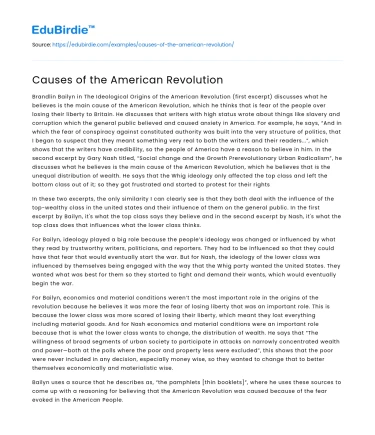Brandlin Bailyn in The Ideological Origins of the American Revolution (first excerpt) discusses what he believes is the main cause of the American Revolution, which he thinks that is fear of the people over losing their liberty to Britain. He discusses that writers with high status wrote about things like slavery and corruption which the general public believed and caused anxiety in America. For example, he says, “And in which the fear of conspiracy against constituted authority was built into the very structure of politics, that I began to suspect that they meant something very real to both the writers and their readers...”, which shows that the writers have credibility, so the people of America have a reason to believe in him. In the second excerpt by Gary Nash titled, “Social change and the Growth Prerevolutionary Urban Radicalism”, he discusses what he believes is the main cause of the American Revolution, which he believes that is the unequal distribution of wealth. He says that the Whig ideology only affected the top class and left the bottom class out of it; so they got frustrated and started to protest for their rights
In these two excerpts, the only similarity I can clearly see is that they both deal with the influence of the top-wealthy class in the united states and their influence of them on the general public. In the first excerpt by Bailyn, it's what the top class says they believe and in the second excerpt by Nash, it's what the top class does that influences what the lower class thinks.
Save your time!
We can take care of your essay
- Proper editing and formatting
- Free revision, title page, and bibliography
- Flexible prices and money-back guarantee
For Bailyn, ideology played a big role because the people’s ideology was changed or influenced by what they read by trustworthy writers, politicians, and reporters. They had to be influenced so that they could have that fear that would eventually start the war. But for Nash, the ideology of the lower class was influenced by themselves being engaged with the way that the Whig party wanted the United States. They wanted what was best for them so they started to fight and demand their wants, which would eventually begin the war.
For Bailyn, economics and material conditions weren’t the most important role in the origins of the revolution because he believes it was more the fear of losing liberty that was an important role. This is because the lower class was more scared of losing their liberty, which meant they lost everything including material goods. And for Nash economics and material conditions were an important role because that is what the lower class wants to change, the distribution of wealth. He says that “The willingness of broad segments of urban society to participate in attacks on narrowly concentrated wealth and power—both at the polls where the poor and property less were excluded”, this shows that the poor were never included in any decision, especially money wise, so they wanted to change that to better themselves economically and materialistic wise.
Bailyn uses a source that he describes as, “the pamphlets [thin booklets]”, where he uses these sources to come up with a reasoning for believing that the American Revolution was caused because of the fear evoked in the American People. But Nash does not use a physical source, he used situations and statics of the economy from this time to draw his conclusions to come up with what he believes cause the American Revolution, which he said was the power of the lower class that wanted change to better themselves economically.
The things that might account for the differences in their interpretations could be their political ideology and what sources they look into and what they read from those sources. Their political ideology might account because it can influence who they favor and whose side they are willing to agree with.
Baylin's argument is supported by John Dickinson, “Letter from a Farmer from Pennsylvania” because they argue that the anxiety of losing their liberty caused them to start wanting change. This is seen in Dickinson, “ For the cause of one is the cause of all. If the parliament may lawfully deprive New York of any of its rights, it may deprive any, or all the other colonies of their rights”, which shows that if they let themselves be stepped on by the British, they will lose their freedom to them and let them have control over them. Both say caused fear which is what caused the American Revolution according to Baylin. For Nash’s argument, the other primary source by Governor Francis Bernard, 'Letter to the Lords of Trade, disagrees with his statement that it was a good thing that the general public was enraged and wanted change because Bernard discuss the negative effects of people rioting and how it affected local towns and townsmen.
Studying these sources I have learned that people can interpret the same document or same event in completely different ways. This all depends on what they want to acknowledge and what they don’t which is how they cultivate their belief of the situation. What I learned about historiography is that it depends on people ideology’s is what affects the way they study it and how they analyze events or documents from the past.






 Stuck on your essay?
Stuck on your essay?

